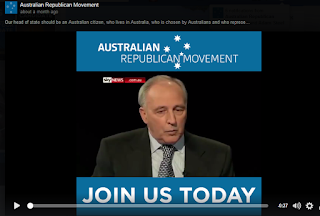It's a great time to be a republican in Australia. The political landscape in Australia is definitely changing. On Australia Day 2016, Australia's premiers and chief ministers made public declarations supporting an Australian head of state. The Prime Minister, Federal Opposition Leader, six premiers and the Chief Justice are now all declared republicans. The Australian Republican Movement has now confirmed most federal MPs and Senators want to ditch the monarchy.
 |
| Prime Minister Malcolm Turnbull and wife Lucy at ARM dinner |
The
Guardian states
that in all, 81 out of 150 members of the House of Representatives, and 40 out
of 76 members of the Senate have declared their support for an Australian
republic, the movement says. According to ARM the number may be even higher as
58 lower house MPs have not stated a position on the republic, with only eleven
lower house MPs listed as committed monarchists. In the upper house, 21
senators were undeclared or undecided and only 15 favour the monarchy. This
Australian Federal Parliament has a 53.5% majority of declared support for the
creation of an Australian republic.
The ARM figures show the
Greens are the most pro-republic, with 100% in support, followed by Labor
(93%). Just 19 Coalition parliamentarians are openly in support of a republic
(17%) although most, 65, are undecided or undeclared. If Labor MPs are bound to
support the republic, support climbs to 86 in the lower house and 42 in the
Senate, or a 56.6% republican majority.
In a new poll released by the ANU
Australian Electoral Study, support for an Australian head of state has hit
53 per cent (reflecting the position of the federal parliament) and outpointed
the 51% result in a Newspoll earlier this year.
The new numbers and
poll were revealed on the eve of Prime Minister Malcolm Turnbull's
highly anticipated speech to the ARM's 25th anniversary dinner. ARM national chair Peter
FitzSimons said
the dinner would “honour those who’ve got us to this point” and Mr Turnbull
was “at the forefront of our founding fathers and mothers”.
“The dinner is also a moment for the ARM to outline its vision for the future. A vision in which Australia takes the lead and completes the journey to full and final independence,” he said.
On Saturday, 17 December 2016 in the Great Hall at the University of Sydney, he outlined a road map toward an Australia head of state. If you haven't seen it, you can read the speech here.
 |
| ARM Mational Chair, Peter Fitzsimons and Turnbulls at Sydney Uni |
As ARM
National Chair, Peter FitzSimons said in response:
"tonight we are re-energised as never before".
However, the
PM also made it clear in his speech that this journey should not begin until
the end of the Queen's reign.
With respect to Prime Minister Turnbull, we disagree.
Becoming a republic is about Us, the Australian people. We can only assert our independence by ushering in an Australian head of state on our own terms and at a time of our choosing.
Our challenge as republicans is to change Malcolm's mind. Luckily, the PM himself told us how we can do this
"house by house, street by street, and suburb by suburb, we must make the case to our fellow citizens."
So that is the plan for 2017. Recruit more members, enlist more volunteers, keep the polls shifting ever northward.
Here are three ways you can help:
- If you're not already a member or your subscription has lapsed, you can join here
- Buy an Australia Day gift membership for that special republican in your life
- Chip in to help grow the campaign by donating here
Make no mistake, the Australian Republican
Movement is back in business. With
majority support in both houses of the federal parliament, Bill
Shorten ready to go, and the PM announcing his road
map to an Australian head of state, we are on the move.
Whether you sign-up as a member, register a friend or donate, now is the moment to put your shoulder to the wheel.
Whether you sign-up as a member, register a friend or donate, now is the moment to put your shoulder to the wheel.







 'Innovative
new security features have been incorporated to help keep Australia’s
banknotes secure from counterfeiting into the future. As can be seen in
the images, these include a distinctive top-to-bottom window. Each
banknote in the new series will depict a different species of Australian
wattle and a native bird within a number of the elements. On the $5
banknote, these are the Prickly Moses wattle and the Eastern Spinebill.'
'Innovative
new security features have been incorporated to help keep Australia’s
banknotes secure from counterfeiting into the future. As can be seen in
the images, these include a distinctive top-to-bottom window. Each
banknote in the new series will depict a different species of Australian
wattle and a native bird within a number of the elements. On the $5
banknote, these are the Prickly Moses wattle and the Eastern Spinebill.'


